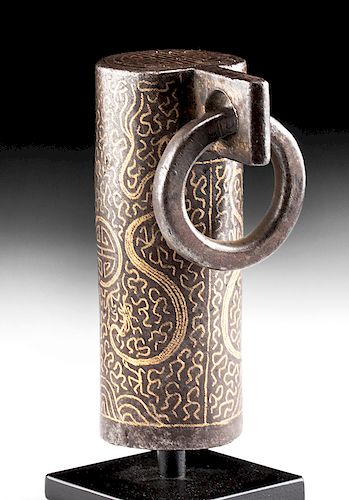16th C. Tibetan Gilded Iron Finial from Buddhist Staff
Lot 85
About Seller
Artemis Fine Arts
686 S Taylor Ave, Ste 106
Louisville, CO 80027
United States
Selling antiquities, ancient and ethnographic art online since 1993, Artemis Gallery specializes in Classical Antiquities (Egyptian, Greek, Roman, Near Eastern), Asian, Pre-Columbian, African / Tribal / Oceanographic art. Our extensive inventory includes pottery, stone, metal, wood, glass and textil...Read more
Categories
Estimate:
$8,000 - $12,000
Absentee vs Live bid
Two ways to bid:
- Leave a max absentee bid and the platform will bid on your behalf up to your maximum bid during the live auction.
- Bid live during the auction and your bids will be submitted real-time to the auctioneer.
Bid Increments
| Price | Bid Increment |
|---|---|
| $0 | $25 |
| $300 | $50 |
| $1,000 | $100 |
| $2,000 | $250 |
| $5,000 | $500 |
| $10,000 | $1,000 |
| $20,000 | $2,500 |
| $50,000 | $5,000 |
| $100,000 | $10,000 |
| $200,000 | $20,000 |
About Auction
By Artemis Fine Arts
Feb 13, 2020
Set Reminder
2020-02-13 10:00:00
2020-02-13 10:00:00
America/New_York
Bidsquare
Bidsquare : Exceptional Antiquities, Asian, Ethnographic
https://www.bidsquare.com/auctions/artemis-gallery/exceptional-antiquities-asian-ethnographic-4848
An important one-day auction featuring museum-worthy examples of Egyptian, Greek, Roman, Etruscan, Near Eastern, Far East / Asian, Pre-Columbian, African / Tribal, Oceanic, Native American, Spanish Colonial, Russian, Fossils, Ancient Jewelry, Fine Art, so much more! Artemis Fine Arts info@artemisgallery.com
An important one-day auction featuring museum-worthy examples of Egyptian, Greek, Roman, Etruscan, Near Eastern, Far East / Asian, Pre-Columbian, African / Tribal, Oceanic, Native American, Spanish Colonial, Russian, Fossils, Ancient Jewelry, Fine Art, so much more! Artemis Fine Arts info@artemisgallery.com
- Lot Description
Central Asia, Tibet, ca. 16th to 17th century CE. A beautiful finial from a Buddhist monk's staff, made of iron with incredibly delicate gold inlays forming a series of swirling motifs around its cylindrical, socket-like form. One side features a loop with a heavy ring projecting from it, used to create noise when it moved to announce the monk's presence. The gold inlays that wrap around the body depict four identical dragons, in two identical pairs flanking a central labyrinthine symbol; below them is a series of mountains, each depicted as a series of rolling, concentric curves. Size: 2.1" W x 3.4" H (5.3 cm x 8.6 cm); 4.25" H (10.8 cm) on included custom stand.
Buddhist priests originally used staffs to climb the steep hills of their Tibetan homeland; these staffs featured attached rings to alert other travelers and animals of their presence. Eventually, this style of staff evolved into the khakkara (also known as the pinyin (China) or shakujo (Japan), an elaborate ceremonial staff with and auspicious number of rings in a set position at the head of the staff. Earlier examples, like this one, feature just one ring. The dragon and labyrinth motifs incised on this finial's surface relate to important concepts in Tibetan Buddhism, with the labyrinth particularly symbolic - it is linked to the mandala, Sanskrit for "circle that contain the Essence", a ring that contains the entirety of the universe used to focus the mind during meditation and ritual.
Provenance: ex-private Hawaii, USA collection, 1970s
All items legal to buy/sell under U.S. Statute covering cultural patrimony Code 2600, CHAPTER 14, and are guaranteed to be as described or your money back.
A Certificate of Authenticity will accompany all winning bids.
We ship worldwide and handle all shipping in-house for your convenience.
#150911Rich patina on the iron surface. Gold inlays have light wear commensurate with age, but the motifs are well preserved.Condition
- Shipping Info
-
All shipping is handled in-house for your convenience. Your invoice from Artemis Gallery will include shipping calculation instructions. If in doubt, please inquire BEFORE bidding for estimated shipping costs for individual items.
-
- Buyer's Premium



 EUR
EUR CAD
CAD AUD
AUD GBP
GBP MXN
MXN HKD
HKD CNY
CNY MYR
MYR SEK
SEK SGD
SGD CHF
CHF THB
THB














